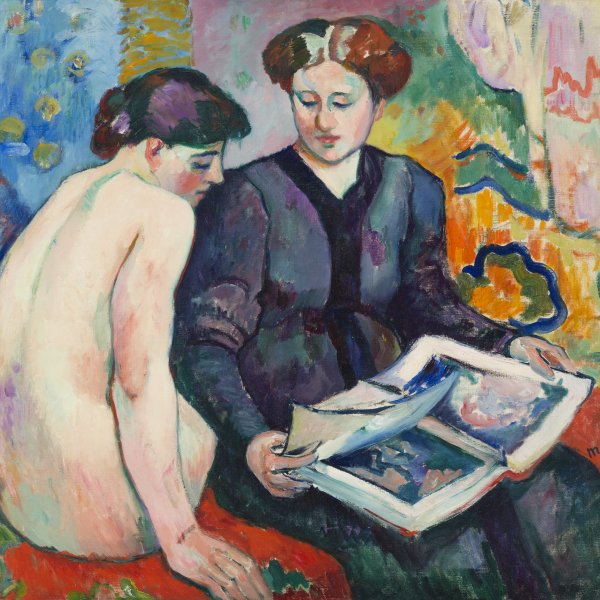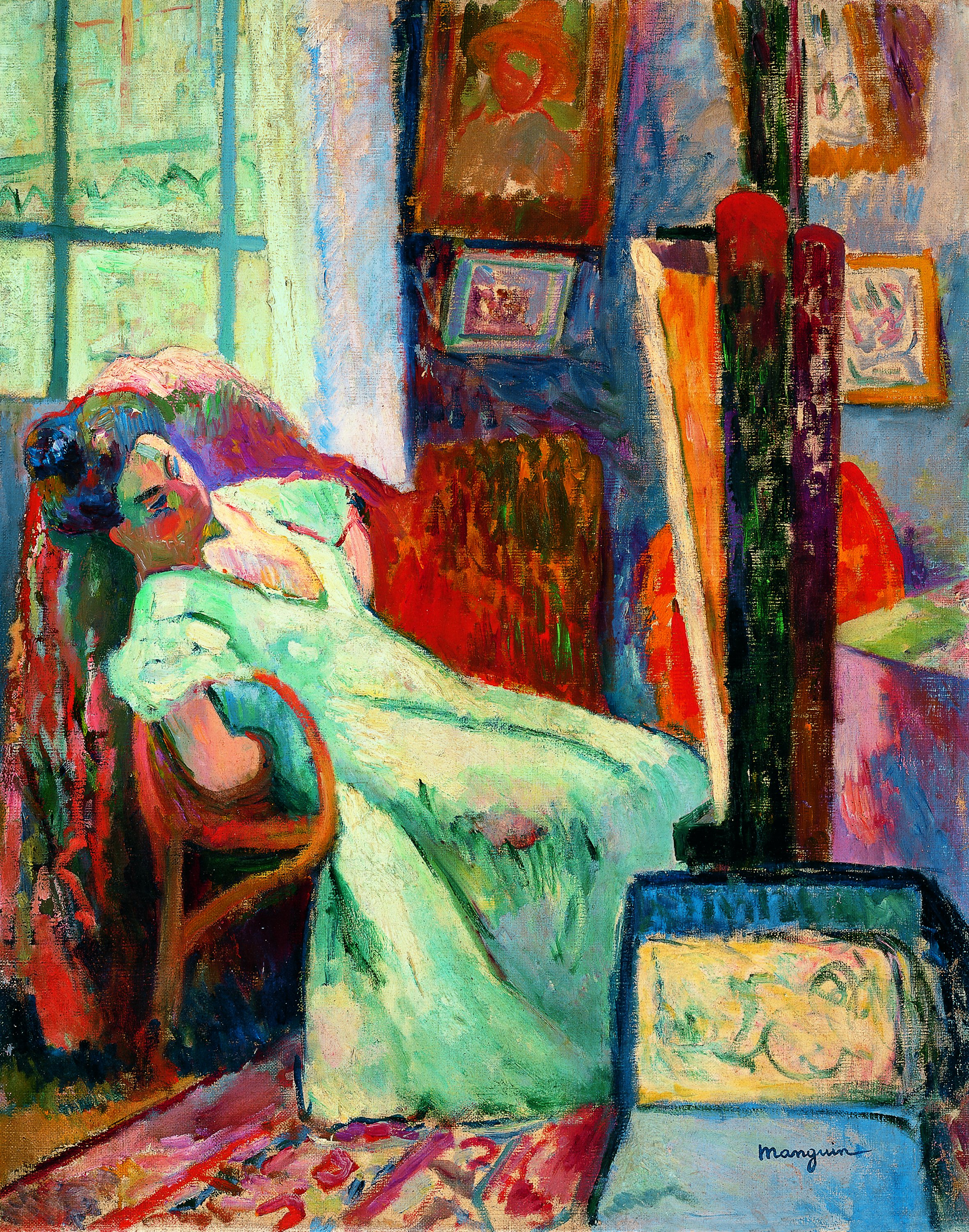Model at Rest
1905
Oil on canvas.
80.7 x 65.7 cm
Carmen Thyssen Collection
Inv. no. (
CTB.1997.14
)
Room H
Level 0
Carmen Thyssen Collection and Temporary exhibition rooms
This painting represents a model sitting in Manguin's studio, a small summerhouse built in the garden of the property the artist had bought when he had got married, in 1899. Since Matisse and Marquet-friends and old colleagues of his from the time of Gustave Moreau's classes at the École des Beaux-Arts, which the three had attended from 1894 till 1897-did not have a studio of their own, they would go to Manguin's when they wanted to paint with a model. The group work sessions, which started in 1903, became more frequent in the winter of 1904-1905.
Three other pictures were also painted that same winter; although closely related to the one analysed here, they differ from Model Resting in the subject matter. In fact, in one of them, by Marquet, Matisse is seen painting in the background. In another one, by Matisse, Marquet appears in the background, working next to a window. In the third, by Manguin, the model is seen from a point of view similar to that in Matisse's picture, but without figures in the background; the chair next to the window facing Marquet's easel is empty. The picture analysed here represents the same corner of the studio, from a slightly different point of view and with the model, who is wearing the gown she uses when she is resting, sitting in Marquet's chair. In front of her, on the easel depicted in profile, there is a painting, slightly tilted forward; on the floor, leaning against the side of the easel, we see an open folder with drawings. The same folder appears, in a very similar position, in Matisse's painting.
This group of works executed by the three friends in Manguin's studio can be considered the greatest achievement of a series of nudes begun around 1900, when Matisse and Marquet enrolled at the Eugène Carrière Academy. The insistence on the study of the nude, a subject very far from the Impressionist and post-Impressionist tradition, is probably the result of Cézanne's influence on Matisse and his friends, who, in their endeavour to find a solution to the classical problems of figure painting, considered the master of Aix a precursor and an example to be followed. In 1899, in spite of his economic difficulties, Matisse had bought from Vollard one painting by Cézanne depicting three bathers. At the same time, the questions raised by the representation of volume induced him to model small clay nudes. Thus, Cézanne's Harlequin (1888-1890), belonging to the Metropolitan Museum of Art, New York, inspired Matisse to paint the so called Nude Study in Blue, 1901, at present in the Tate Gallery, London, which in turn is the departure point for one of his first sculptures, Madeleine I (c. 1901). The nude painted in Manguin's studio may have been at the origin of two standing nudes modelled in 1906.
Model Resting, painted at a time when Manguin had developed a very close friendship with the artists that, like him, would shortly after be known as fauves, is also a response to the quest for a new pictorial language on which he had embarked with his friends. It is nevertheless a complex composition. The fact that the model is dressed and seated in a corner of the studio relegates sculptural considerations to a secondary plane. The chiaroscuro effect on the female figure, and the shape of the window, counterbalanced by the vigorous vertical planes of the easel, evoke the Nabis and their search for a pictorial space without perspective. On the other hand, the intense and saturated palette recalls Gauguin, an artist admired by Marquet and Manguin and whose death in 1903 (but heard about later) had affected them deeply. Finally, the position of the woman, depicted relaxing after a tiring modelling session, echoes Degas' interest in grasping and fixing the more personal and elusive expressions of his models.
Tomàs Llorens
Three other pictures were also painted that same winter; although closely related to the one analysed here, they differ from Model Resting in the subject matter. In fact, in one of them, by Marquet, Matisse is seen painting in the background. In another one, by Matisse, Marquet appears in the background, working next to a window. In the third, by Manguin, the model is seen from a point of view similar to that in Matisse's picture, but without figures in the background; the chair next to the window facing Marquet's easel is empty. The picture analysed here represents the same corner of the studio, from a slightly different point of view and with the model, who is wearing the gown she uses when she is resting, sitting in Marquet's chair. In front of her, on the easel depicted in profile, there is a painting, slightly tilted forward; on the floor, leaning against the side of the easel, we see an open folder with drawings. The same folder appears, in a very similar position, in Matisse's painting.
This group of works executed by the three friends in Manguin's studio can be considered the greatest achievement of a series of nudes begun around 1900, when Matisse and Marquet enrolled at the Eugène Carrière Academy. The insistence on the study of the nude, a subject very far from the Impressionist and post-Impressionist tradition, is probably the result of Cézanne's influence on Matisse and his friends, who, in their endeavour to find a solution to the classical problems of figure painting, considered the master of Aix a precursor and an example to be followed. In 1899, in spite of his economic difficulties, Matisse had bought from Vollard one painting by Cézanne depicting three bathers. At the same time, the questions raised by the representation of volume induced him to model small clay nudes. Thus, Cézanne's Harlequin (1888-1890), belonging to the Metropolitan Museum of Art, New York, inspired Matisse to paint the so called Nude Study in Blue, 1901, at present in the Tate Gallery, London, which in turn is the departure point for one of his first sculptures, Madeleine I (c. 1901). The nude painted in Manguin's studio may have been at the origin of two standing nudes modelled in 1906.
Model Resting, painted at a time when Manguin had developed a very close friendship with the artists that, like him, would shortly after be known as fauves, is also a response to the quest for a new pictorial language on which he had embarked with his friends. It is nevertheless a complex composition. The fact that the model is dressed and seated in a corner of the studio relegates sculptural considerations to a secondary plane. The chiaroscuro effect on the female figure, and the shape of the window, counterbalanced by the vigorous vertical planes of the easel, evoke the Nabis and their search for a pictorial space without perspective. On the other hand, the intense and saturated palette recalls Gauguin, an artist admired by Marquet and Manguin and whose death in 1903 (but heard about later) had affected them deeply. Finally, the position of the woman, depicted relaxing after a tiring modelling session, echoes Degas' interest in grasping and fixing the more personal and elusive expressions of his models.
Tomàs Llorens






